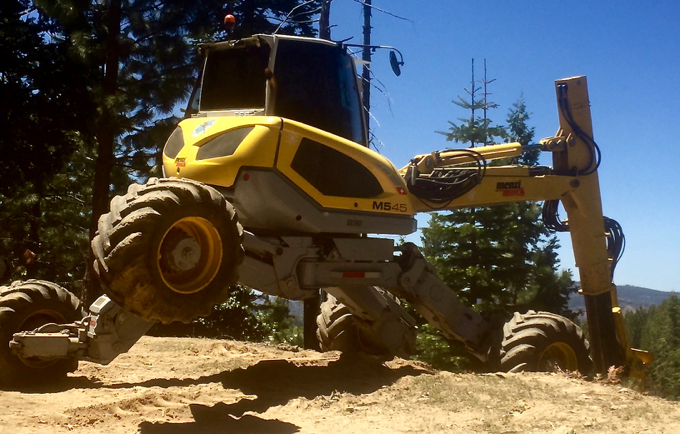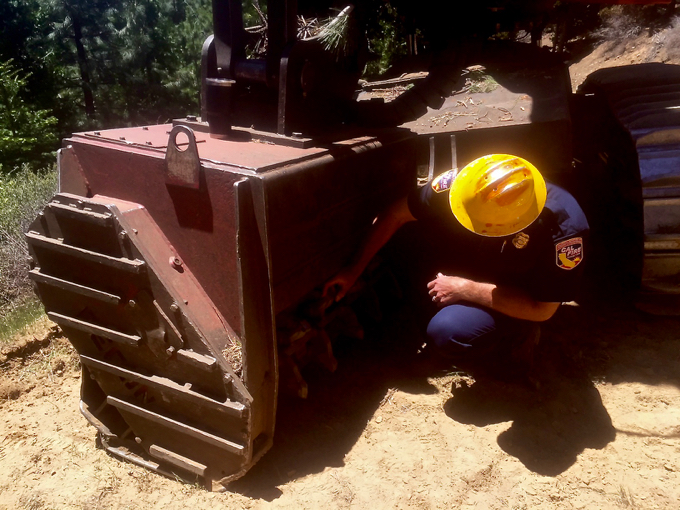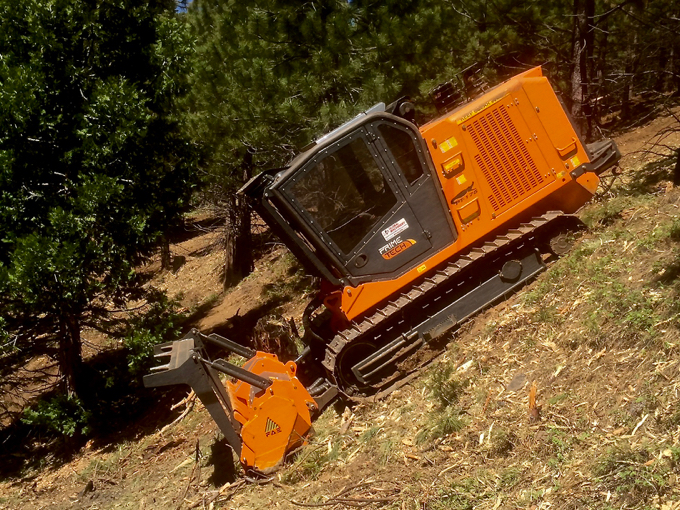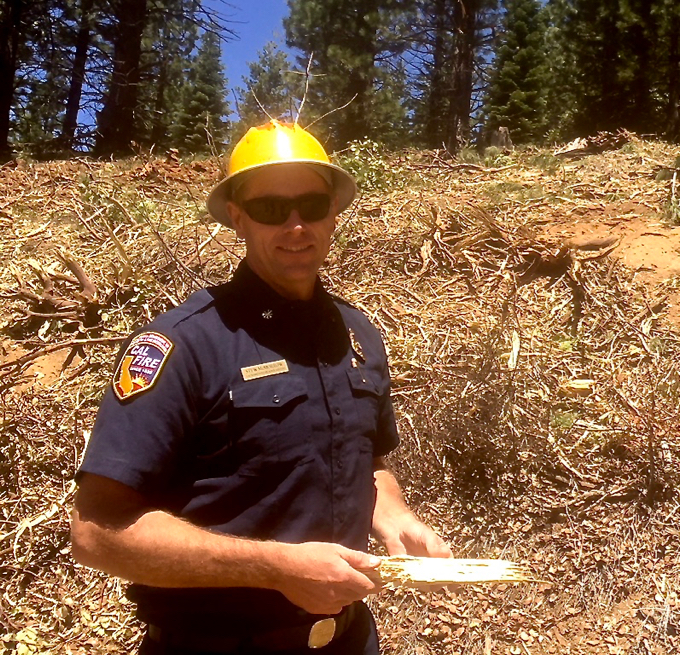
The Spider looks like a Transformer ready to tromp through the forest. Photo/Susan Wood
By Susan Wood
POLLOCK PINES – Relying heavily on prescribed burns as fuel reduction among forest officials may be steeped in tradition – but the practice isn’t enough to fight the types of raging infernos the West is seeing year after year.
Much of the challenge often lies in fire prevention over steep terrain requiring a cross between the old and the new. It takes oversized Tonka trucks and Transformer-type heavy equipment.
California is coming off a series of drought years, then one of the worst seasons ever for wildland blazes on the 25th anniversary of the Cleveland Fire. The mega blaze burned more than 24,000 acres in 30 hours, closed a 50-mile stretch of Highway 50, killed two people and injured 72. The hot fire that roared eight miles east of Pollock Pines along the Peavine Ridge north of Riverton at Ice House Road presents a painful reminder of what could be.
Another more recent blaze nearby — the King Fire of 2014 — scorched more than 97,000 acres in El Dorado County and destroyed 80 structures. The fire’s cause was arson, but the damage is still visible from the highway and restoration is ongoing.
The terrain is thick, steep and unforgiving to get to off the roads.

CalFire Deputy Chief Stewart McMorrow looks at the chewing teeth of the TimberPro attachment. Photo/Susan Wood
“We’ve spent $6 million to restore 11 Pines Road, and it’s still closed,” Eldorado National Forest Supervisor Laurence Crabtree told Lake Tahoe News preceding a tour last week from the Ice House Resort 10 miles up from Riverton.
The U.S. Forest Service spends over half its budget on fighting fires, knowing prevention is where the emphasis needs to be.
Forest managers were joined to view the equipment and results up close by small groups of residents, Sierra Pacific Industries and CalFire officials, who declared a suspension to burning starting today in El Dorado, Amador and Alpine counties. Some see the declaration as the official start of fire season. Others would agree fire season has turned into a yearlong event.
Crabtree estimated at least 35 percent of the burn area with a mix of conifer trees such as fir, pine and cedar from the King Fire is steep, posing a hazard to property owners – especially as more build in the wildland interface. In the last five years, Forest Service officials have negotiated agreements with private property owners to establish firebreaks on their land.
Among them is Sierra Pacific Industries – which manages the resources on 1.8 million acres in California.

The excavation machine made by Pacific Tech handles the steep terrain of the Eldorado Forest. Photo/Susan Wood
“We need to manage fire; we don’t need it to manage us,” Sierra Pacific spokesman Mark Luster summarized about the tree-clearing demonstration.
Take an overgrown forest with mass pockets of dead trees in timber-dry conditions, an excess of fuel following wet winters while throwing in windy conditions, and California is ripe for a no-win perfect storm of fire capable of producing the kind of huge complexes that ripped through the Wine Country last year.
Firefighters regionwide are quite aware of how vulnerable the rugged, woody Sierra Nevada Mountain Range is – especially in hard-to-get-to, steep terrain.
Fire science proves flames burn faster up steep slopes. Unfortunately, this terrain makes it difficult for firefighters to cover the ground necessary to build a perimeter to contain and control fires that hop from low-lying brush, to ladder fuels up to the crown.
That’s one reason managing the resources ahead of the worst time of year in fire season may seem like a never-ending task when other forces like drought and bark beetle stack on the obstacles.
Sometimes it’s just as hard to manage the people doing the work of clearing the debris.
Contractor Jeff Holland quipped that his company of 30 machines and 25 people said his company has grown increasingly busy since 1983 since the forest has been “mismanaged.”
To that, Luster countered that the job is overwhelming anyway.
“If you look at how much acreage, there’s so much volume, it’s hard to keep up with the amount of volume,” he said.
CalFire Deputy Chief Steward McMorrow, who works out of Sacramento, agreed.
“What we’re doing here is rearranging the fuels on the lower forest floor,” McMorrow said as he glanced over a cleared segment of acreage where the Timberpro harvester had gone through. He contends that environmentally chewing the trees and leveling the land also helps to stimulate the fungal process.
The goal of the equipment demonstration: To witness how the latest and greatest in excavating, skidding, moving and mulching equipment can clear a fire prone region in steep terrain by digesting woody debris in ways unheard of decades ago. The key is in the equipment attachments assembled to address the job, the level of fineness and the terrain.
Some of these heavy-equipment machines look like something out of an animated space film – such as one called the “spider.” The walking excavator made by Menzi of Switzerland essentially crawls down the hills with the use of four independently-operated mega wheels, front stabilizers and a loader appendage that helps it crawl up and down a slope of at least 40 degrees with ease. The 30,000-pound machine looks like a living thing when it lays flat or arches its back.
“It can collapse down to 7-feet wide,” said equipment operator Eric Monson, whose Atascadero-based Stroles Tri Service company contracts with Sierra Pacific and the U.S. Forest Service to clear the thick forest in hard-to-treat fuel reduction regions.

CalFire Deputy Chief Stewart McMorrow surveys the land cleared by a tree harvester. Photo/Susan Wood
Down the road, Brian Kile, the western regional manager of Fecon, explained how his agile track mulcher can handle steep slopes of 45 degrees. The finished byproduct looked like something homeowners might be happy with in their own back yard. The mulcher was put to the test during the West Yellowstone fires, serving as an emergency fire break.
“This thing can blow dirt and can (at times) put a low-ground fire out,” Kile said with pride.
Bruce Jackson, displaying ASV’s skid steers and track loaders, noted to the tour group how pleased he is with the performance of his equipment in the steep terrain of the Eldorado Forest.
“You have to do something drastic to flip it,” he said.
Jackson also insisted the cooling system makes his machine superior in that it can work for prolonged periods without overheating.
All in all, the heavy equipment of today isn’t your grandfather’s and plays a more important role in human survival than dirt excavation.
This is a video the Sacramento Bee shared with LTN showing the equipment in action.



